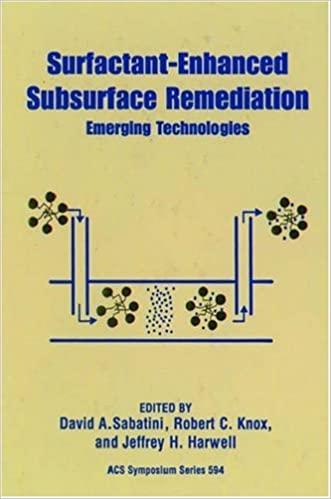Question
i. The elementary non-reversible organic liquid phase reaction A + B C is conducted adiabatically in a continuous reactor. Equimolar inputs to A and B
i. The elementary non-reversible organic liquid phase reaction A + B C is conducted adiabatically in a continuous reactor. Equimolar inputs to A and B enter at a temperature of 27 C, and the volumetric flow rate is 2 dm3/s and C0A = 0.1 kmol/m3. More information: H0B(273)=-15 kcal/mol, H0C(273)=-41 kcal/mol, kr=0.01 dm3/(mol s) at 300K, H0A(273)=-20 kcal/mol, CpA=CpB=15 cal/(mol K), CpC=30 cal/(mol K), E=1000 cal/mol, 1 dm3=0.001 m3 (a) What is the necessary CSTR volume and CSTR outlet temperature to achieve 85% conversion? (b) What is the maximum inlet temperature that can be reached?
ii. Hydrogen sulfide is absorbed in a stationary column containing methanolamine (MEA) solution. The gas pressure at the top of the column is 20 atm and its H2S content is 0.1%, while the solution contains 250 mol/m3 of free MEA. The diffusion rate of MEA in solution is equal to 0.64 of that of H2S. The reaction is normally considered to be irreversible and very fast (instantaneous). H2S + RNH2 HS- + RNH-3 , where A: H2S and B:RNH2 For the flow tayes and column packing used apply: kAga= 60 mol/(m3 atm), kAla=0.03 s-1 , HA= 10-4 m3 atm/mol the Henry's law constant for H2S in water. (c) Find the rate of absorption of H2S from the MEA solution and locate the reaction zone. (d) Investigate whether MEA is worth using for absorption. Determine how much faster the absorption is with MEA compared to that with pure water.
Step by Step Solution
There are 3 Steps involved in it
Step: 1

Get Instant Access to Expert-Tailored Solutions
See step-by-step solutions with expert insights and AI powered tools for academic success
Step: 2

Step: 3

Ace Your Homework with AI
Get the answers you need in no time with our AI-driven, step-by-step assistance
Get Started


